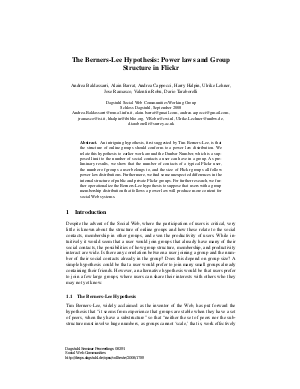08391 Group Summary – The Berners-Lee Hypothesis: Power laws and Group Structure in Flickr
Authors Andrea Baldassarri, Alain Barrat, Andrea Capocci, Harry Halpin, Ulrike Lehner, Jose Ramasco, Valentin Robu, Dario Taraborelli
-
Part of:
Volume:
Dagstuhl Seminar Proceedings, Volume 8391
Part of: Series: Dagstuhl Seminar Proceedings (DagSemProc) - License:
 Creative Commons Attribution 4.0 International license
Creative Commons Attribution 4.0 International license
- Publication Date: 2008-12-22
File

PDF
DagSemProc.08391.4.pdf
- Filesize: 188 kB
- 11 pages
Document Identifiers
Subject Classification
Keywords
- Social group flickr powerlaw
Metrics
- Access Statistics
-
Total Accesses (updated on a weekly basis)
0Document
0Metadata
Abstract
An intriguing hypothesis, first suggested by Tim Berners-Lee, is that the structure of online groups should conform to a power law distribution. We relate this hypothesis to earlier work around the Dunbar Number, which is a supposed limit to the number of social contacts a user can have in a group. As preliminary results, we show that the number of contacts of a typical Flickr user, the number of groups a user belongs to, and the size of Flickr groups all follow power law distributions. Furthermore, we find some unexpected differences in the internal structure of public and private Flickr groups. For further research, we further operationalize the Berners-Lee hypothesis to suppose that users with a group membership distribution that follows a power law will produce more content for social Web systems.
Cite As Get BibTex
Andrea Baldassarri, Alain Barrat, Andrea Capocci, Harry Halpin, Ulrike Lehner, Jose Ramasco, Valentin Robu, and Dario Taraborelli. 08391 Group Summary – The Berners-Lee Hypothesis: Power laws and Group Structure in Flickr. In Social Web Communities. Dagstuhl Seminar Proceedings, Volume 8391, pp. 1-11, Schloss Dagstuhl – Leibniz-Zentrum für Informatik (2008)
https://doi.org/10.4230/DagSemProc.08391.4
BibTex
@InProceedings{baldassarri_et_al:DagSemProc.08391.4,
author = {Baldassarri, Andrea and Barrat, Alain and Capocci, Andrea and Halpin, Harry and Lehner, Ulrike and Ramasco, Jose and Robu, Valentin and Taraborelli, Dario},
title = {{08391 Group Summary – The Berners-Lee Hypothesis: Power laws and Group Structure in Flickr}},
booktitle = {Social Web Communities},
pages = {1--11},
series = {Dagstuhl Seminar Proceedings (DagSemProc)},
ISSN = {1862-4405},
year = {2008},
volume = {8391},
editor = {Harith Alani and Steffen Staab and Gerd Stumme},
publisher = {Schloss Dagstuhl -- Leibniz-Zentrum f{\"u}r Informatik},
address = {Dagstuhl, Germany},
URL = {https://drops.dagstuhl.de/entities/document/10.4230/DagSemProc.08391.4},
URN = {urn:nbn:de:0030-drops-17893},
doi = {10.4230/DagSemProc.08391.4},
annote = {Keywords: Social group flickr powerlaw}
}
